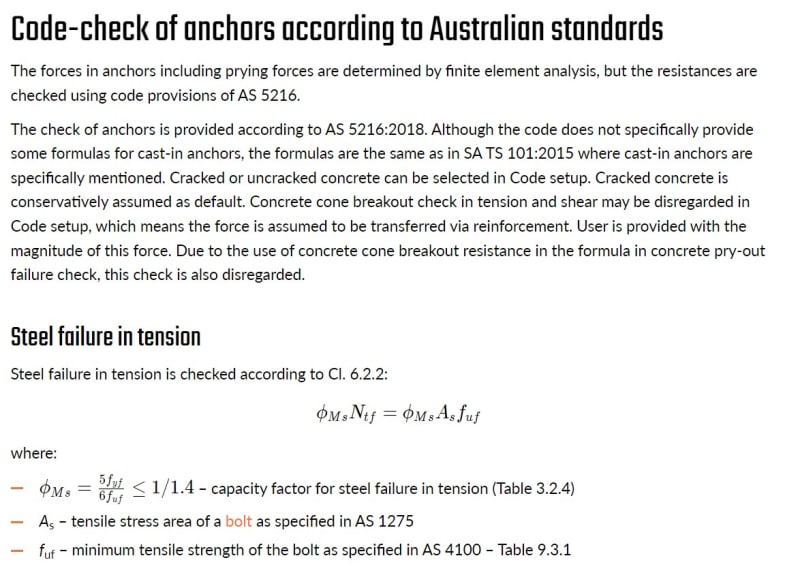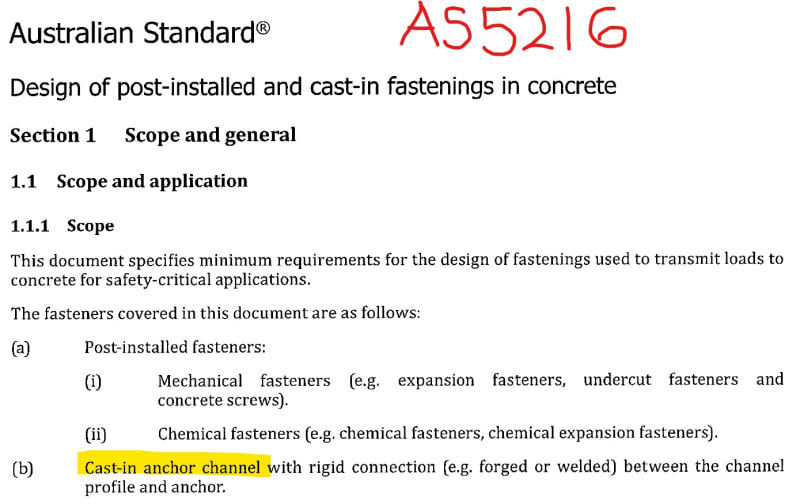Hi,
I believe there is some ambiguity relating to AS5216 and whether this standard applies to the design of cast-in anchor bolts. The title of the standard seems to suggest that it applies to all cast-in fasteners, however the scope section of the standard explicity mentions cast-in anchor channels only.
The reason I bring this up is that recently I have been using the connection design software Idea Statica to design a column base plate with significant tension/uplift forces through it, and that uses cast-in hold down bolts to fix the base plate to the concrete. I noticed the Idea Statica was telling me that my anchors were failing tension checks (steel failure). On closer review of the calcs I noticed that Idea Statica was using AS5216 to check the anchor bolts. I subsequently found the attached notes on the Idea Statica website discussing why they use AS5216. They mention that SA TS 101:2015 (the technical document that AS5216 eventually replaced) specifically mentioneds cast-in anchors, however when I look at the scope section of that document, it explicity states that it only applies to post-fixed anchors and cast-in anchor channels. This is also the case in AS5216 as seen in the attached screenshot. To be honest I think AS5216 does use the term 'cast-in fastener' rather loosely.
The major difference between using AS5216 or AS4100 when checking the tension capacity of HD anchor bolts capacity has to do with the capacity reduction factor. AS4100 (and consequently the ASI Connection Design Guides) uses a fixed capacity reduction factor value of 0.8 for bolt tension checks. AS5216 uses an equation that proportions the capacity reduction factor based on the yield strength and UTS of the bolt. For a grade 4.6 HD bolt the reduction factor comes out to 0.5. That makes a huge difference to the bolt tension capacity between the two standards!
So my question is what standard do you use for your cast-in anchor bolt design? I tend to use AS4100 for bolt steel checks, and AS5216 for concrete checks.


I believe there is some ambiguity relating to AS5216 and whether this standard applies to the design of cast-in anchor bolts. The title of the standard seems to suggest that it applies to all cast-in fasteners, however the scope section of the standard explicity mentions cast-in anchor channels only.
The reason I bring this up is that recently I have been using the connection design software Idea Statica to design a column base plate with significant tension/uplift forces through it, and that uses cast-in hold down bolts to fix the base plate to the concrete. I noticed the Idea Statica was telling me that my anchors were failing tension checks (steel failure). On closer review of the calcs I noticed that Idea Statica was using AS5216 to check the anchor bolts. I subsequently found the attached notes on the Idea Statica website discussing why they use AS5216. They mention that SA TS 101:2015 (the technical document that AS5216 eventually replaced) specifically mentioneds cast-in anchors, however when I look at the scope section of that document, it explicity states that it only applies to post-fixed anchors and cast-in anchor channels. This is also the case in AS5216 as seen in the attached screenshot. To be honest I think AS5216 does use the term 'cast-in fastener' rather loosely.
The major difference between using AS5216 or AS4100 when checking the tension capacity of HD anchor bolts capacity has to do with the capacity reduction factor. AS4100 (and consequently the ASI Connection Design Guides) uses a fixed capacity reduction factor value of 0.8 for bolt tension checks. AS5216 uses an equation that proportions the capacity reduction factor based on the yield strength and UTS of the bolt. For a grade 4.6 HD bolt the reduction factor comes out to 0.5. That makes a huge difference to the bolt tension capacity between the two standards!
So my question is what standard do you use for your cast-in anchor bolt design? I tend to use AS4100 for bolt steel checks, and AS5216 for concrete checks.


